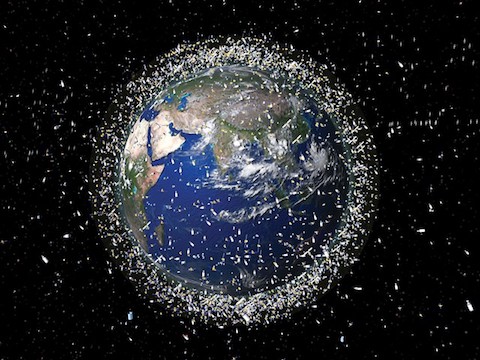Europe plans to launch space telescope to monitor orbital debris
There is no orbiting space junk telescope yet and it could make space quite a bit safer.

The European Space Agency (ESA) wants to launch an orbiting telescope to monitor pieces of space debris as small as a few millimeters across. Such tiny fragments of space junk are too small to be spotted with ground-based telescopes, but if they hit a spacecraft, they can cause serious damage.
ESA hopes the satellite, the first of its kind, makes it to space in 2025, provided it gets funding approval at the 2022 council of ESA member states.
The spacecraft, carrying an 8-inche-wide (20 centimeters) optical telescope, would orbit at the altitude of 370 to 430 miles (600 to 700 kilometers), where computer models run by ESA and NASA predict a high density of small space debris fragments, Tim Flohrer, the Head of ESA's Space Debris Office told Space.com.
"The telescope would be completely passive, working on the principle that the sun illuminates the object and we then detect the reflection from the object," Flohrer said. "We have to get rather close to the objects. We would not be able to see every object in the millimeter or centimeter range, but we would see enough to validate our models."
NASA and ESA both run their own space debris models using different approaches, Flohrer said. The models agree on the distribution of larger debris pieces in the orbital environment, which can be validated by ground-based telescopes. But when it comes to smaller fragments, the models’ predictions diverge.
"In the centrimeter regime, we have no real validation means available, and that's where we see quite significant disagreement between the models," Flohrer said. "That needs to be tackled because a 1-centimeter [0.4 inches] object can still cause severe damage to an operating satellite. An object of several centimeters could even destroy the satellite."
ESA has firsthand experience with the wrecking power of tiny space debris. In August 2016, a particle only about a millimeter in diameter punched through a solar panel of the Copernicus Sentinel-1A Earth-observing satellite operated by the agency. Spacecraft operators identified what caused the sudden drop in power generation thanks to onboard cameras designed to monitor the unfolding of the solar panels after launch.
Get the Space.com Newsletter
Breaking space news, the latest updates on rocket launches, skywatching events and more!
Copernicus Sentinel-1A was able to continue its mission. But the consequences would have been much more severe had the space bullet, which was traveling at 17,000 mph (28,000 kph), hit the main body of the spacecraft, ESA officials said.
ESA estimates that approximately 34,000 space debris pieces larger than 4 inches (10 cm) currently orbit Earth. The number of fragments between 0.4 and 4 inches (1 to 10 cm) is believed to be around 900,000. In addition to that, there could be a staggering 128 million objects between 0.04 and 0.4 inches (1 millimeter to 1 cm)r in size.
Related: Artificial intelligence is learning how to dodge space junk in orbit
"The smaller the objects, the more numerous they are," Holger Krag, the head of Space Safety at ESA, said at a press briefing during the 8th European Space Debris Conference last week. "Only a very small fraction can actually be seen, but all of them are dangerous because of their high velocities. Unfortunately, what you cannot see, you cannot avoid."
He added that even a relatively small orbiting telescope would make a big difference in the understanding of the distribution of these dangerous fragments.
“Such a telescope would be able to detect objects of even a few millimeters in size, which are otherwise unobservable from the ground,” Krag said.
Flohrer added that ESA will soon release an invitation to tender for companies to develop components for the telescope. But the mission still needs to obtain some of the required funding at the 2022 council of ESA member states, he said.
Follow Tereza Pultarova on Twitter @TerezaPultarova. Follow us on Twitter @Spacedotcom and on Facebook.
Join our Space Forums to keep talking space on the latest missions, night sky and more! And if you have a news tip, correction or comment, let us know at: community@space.com.

Tereza is a London-based science and technology journalist, aspiring fiction writer and amateur gymnast. Originally from Prague, the Czech Republic, she spent the first seven years of her career working as a reporter, script-writer and presenter for various TV programmes of the Czech Public Service Television. She later took a career break to pursue further education and added a Master's in Science from the International Space University, France, to her Bachelor's in Journalism and Master's in Cultural Anthropology from Prague's Charles University. She worked as a reporter at the Engineering and Technology magazine, freelanced for a range of publications including Live Science, Space.com, Professional Engineering, Via Satellite and Space News and served as a maternity cover science editor at the European Space Agency.









